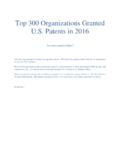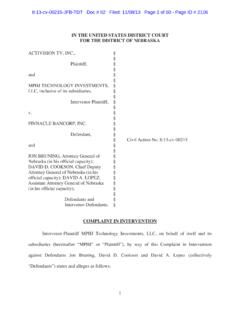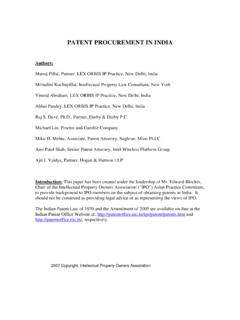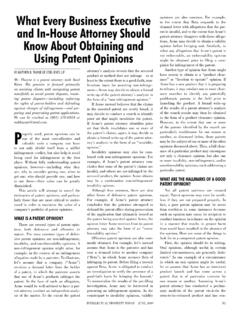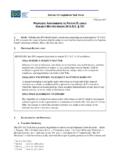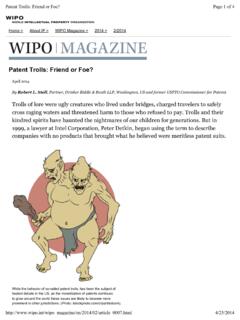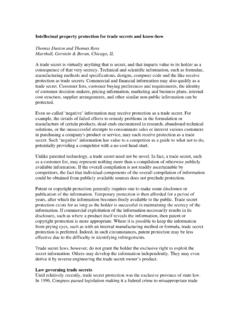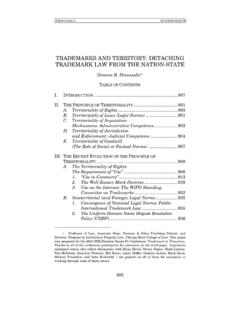Transcription of TRADEMARK OPPOSITIONS IN THE UNITED …
1 TRADEMARK OPPOSITIONS in the USA Curtis Krechevsky, Esq., Partner and Chair of TRADEMARK & Copyright Department, Cantor Colburn LLP, US Copyright 2014 Curtis Krechevsky. All Rights Reserved. 1 TRADEMARK OPPOSITIONS IN THE UNITED STATES OF AMERICA Curtis Krechevsky, Esq., Partner and Chair of TRADEMARK & Copyright Department, Cantor Colburn LLP, US1 I. Introduction to TRADEMARK OPPOSITIONS 1. This paper is intended to provide an overview of TRADEMARK OPPOSITIONS in the UNITED States. Practical considerations for deciding whether to file and how to litigate an opposition are also discussed.
2 2. In the UNITED States, OPPOSITIONS are filed with and heard by the TRADEMARK Trial and Appeal Board ( TTAB ) of the UNITED States Patent and TRADEMARK Office ( USPTO ). The USPTO, an agency of the UNITED States Department of Commerce, administers the national TRADEMARK registry of the UNITED States, also known as the federal registry. (Each of the 50 individual states in the , plus the territory of the Commonwealth of Puerto Rico, maintain their own state TRADEMARK registries. Except for Puerto Rico, none of the states currently offers the ability to oppose a state TRADEMARK application.)
3 3. A TRADEMARK opposition is defined as an objection by a third party to a pending federal application after publication, and before a registration has been granted. OPPOSITIONS in the UNITED States are therefore categorized as pre-grant, rather than post-grant, proceedings. 4. The parties to an opposition are known as the Opposer or Opponent (the objecting party) and the Applicant (owner of the opposed application). II. TTAB Jurisdiction for OPPOSITIONS A. The TTAB 1. The TTAB is an administrative adjudicatory body residing within the USPTO, authorized by the TRADEMARK Law (also known as the Lanham Act ) to hear and decide TRADEMARK OPPOSITIONS .
4 The TTAB has exclusive jurisdiction to hear and decide OPPOSITIONS to federal applications. An opposition cannot be filed in the federal or state trial courts, even as a companion claim to a larger related dispute, such as a TRADEMARK infringement complaint. 2. The TTAB also hears and decides petitions to cancel federal registrations ( TRADEMARK cancellation proceedings), appeals from final USPTO decisions on applications (typically where the application has received a final refusal), and certain other proceedings under the Lanham Act.
5 1 The author wishes to thank Thomas J. Mango, Counsel at Cantor Colburn LLP, for his valuable assistance in the research and preparation of this paper. TRADEMARK OPPOSITIONS in the USA Curtis Krechevsky, Esq., Partner and Chair of TRADEMARK & Copyright Department, Cantor Colburn LLP, US Copyright 2014 Curtis Krechevsky. All Rights Reserved. 2 B. The TTAB Judges 1. OPPOSITIONS are decided by administrative TRADEMARK judges. A panel of three judges hears each opposition and issues a written decision (also known as an opinion ).
6 TTAB decisions are either unanimous or by majority (2-1) vote. Dissenting judges can and occasionally do file their own opinions. 2. The administrative judges are very knowledgeable in TRADEMARK law, and are appointed by the Secretary of Commerce, in consultation with the Director of the USPTO. Once appointed the judges serve full-time for the TTAB. Prior to their appointments, judges often have acquired substantial TRADEMARK experience in private practice, at the USPTO, or in academia. 3. As of March 2014, the TTAB had 21 sitting judges. III.
7 Time Period to Oppose and Extensions of Time A. Publication for opposition 1. Applications are published for opposition in the weekly USPTO TRADEMARK Gazette, available electronically or for download via the USPTO website. 2. Once the USPTO publishes an application for opposition , a potential Opposer initially has thirty (30) calendar days within which to file a Notice of opposition , or a request to extend the time to file a Notice of opposition . B. Extensions of Time to Oppose 1. The UNITED States permits extensions of time to oppose published applications.
8 2. The initial thirty (30) day opposition period may be extended if the potential Opposer files an extension request with the TTAB. 3. However, note that any request for extension of time is communicated by the TTAB to the Applicant or Applicant s designated representative by the TTAB. Thus even requesting an extension of time puts the Applicant on notice that the potential Opposer has some concerns about the application. 4. Without needing to contact Applicant or to obtain Applicant s consent, the potential Opposer may extend the opposition deadline for a total of ninety (90) additional days, yielding a total opposition period of one hundred twenty (120) days from the date of publication.
9 5. The potential Opposer may file a request for a thirty (30) day extension as a matter of right (without cause and without Applicant s consent). TRADEMARK OPPOSITIONS in the USA Curtis Krechevsky, Esq., Partner and Chair of TRADEMARK & Copyright Department, Cantor Colburn LLP, US Copyright 2014 Curtis Krechevsky. All Rights Reserved. 3 6. If necessary or desired, the potential Opposer may then file a second request for an additional sixty (60) day extension, again without Applicant s consent, but this time showing some basis for cause for the additional extension request (for example, the potential Opposer s need to further investigate the matter, to confer with counsel, or to engage or continue in settlement discussions).
10 7. Alternatively, Opposer may file a single extension request, within the initial thirty (30) day period, without Applicant s consent, but showing a basis for cause, for a ninety (90) day extension. 8. Once the potential Opposer has obtained extensions of time totaling ninety (90) days, Opposer can only extend the opposition deadline with Applicant s consent absent extraordinary circumstances. The TTAB normally permits only one final consented-to extension, for a period of sixty (60) additional days. C. TTAB Deadlines That Do Not Fall on Normal Business Days 1.
